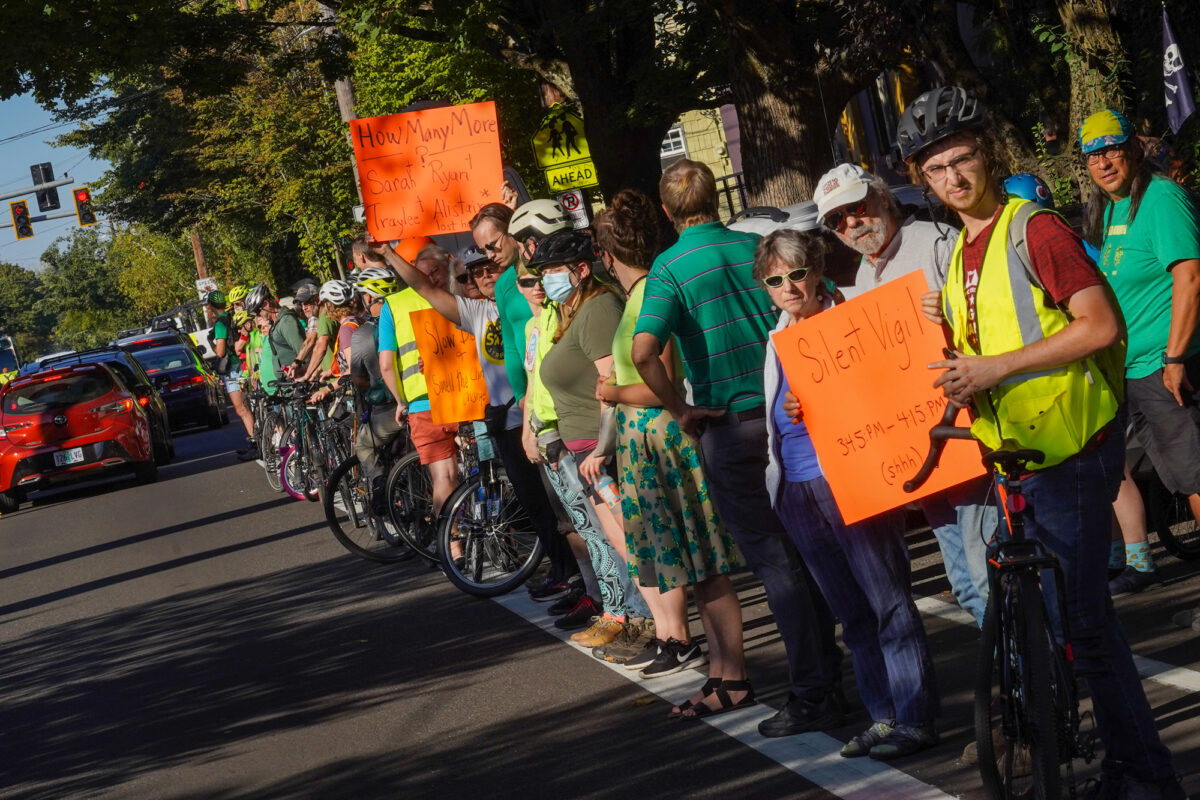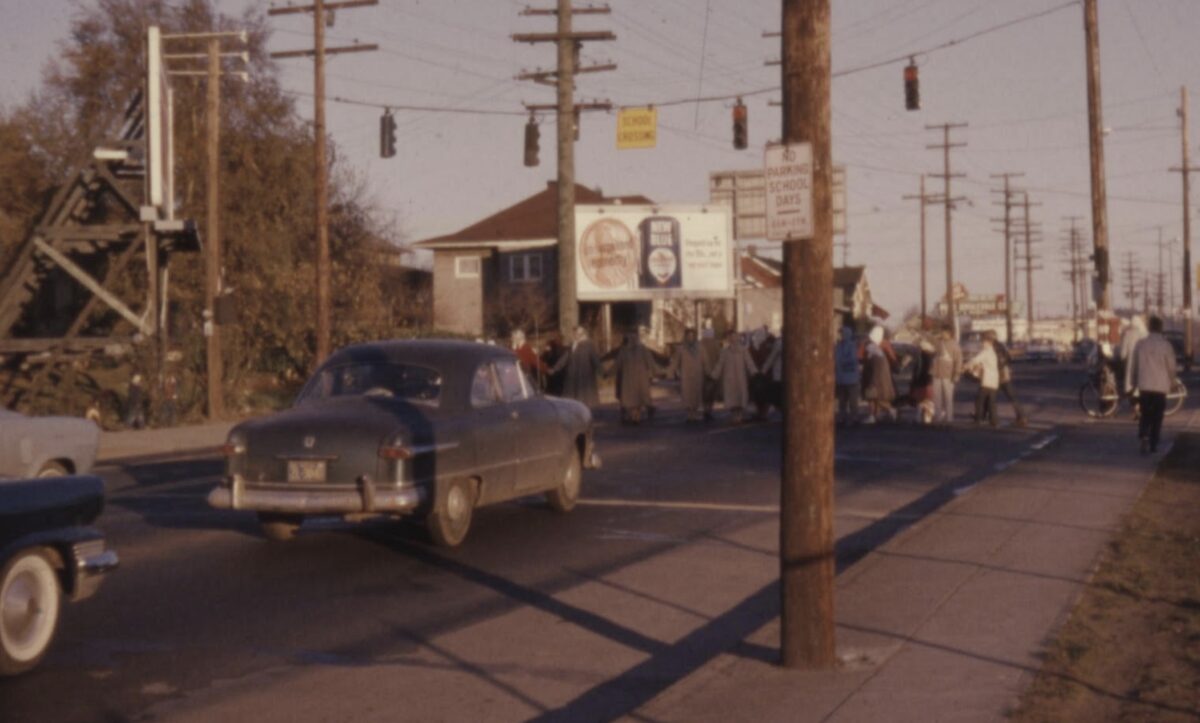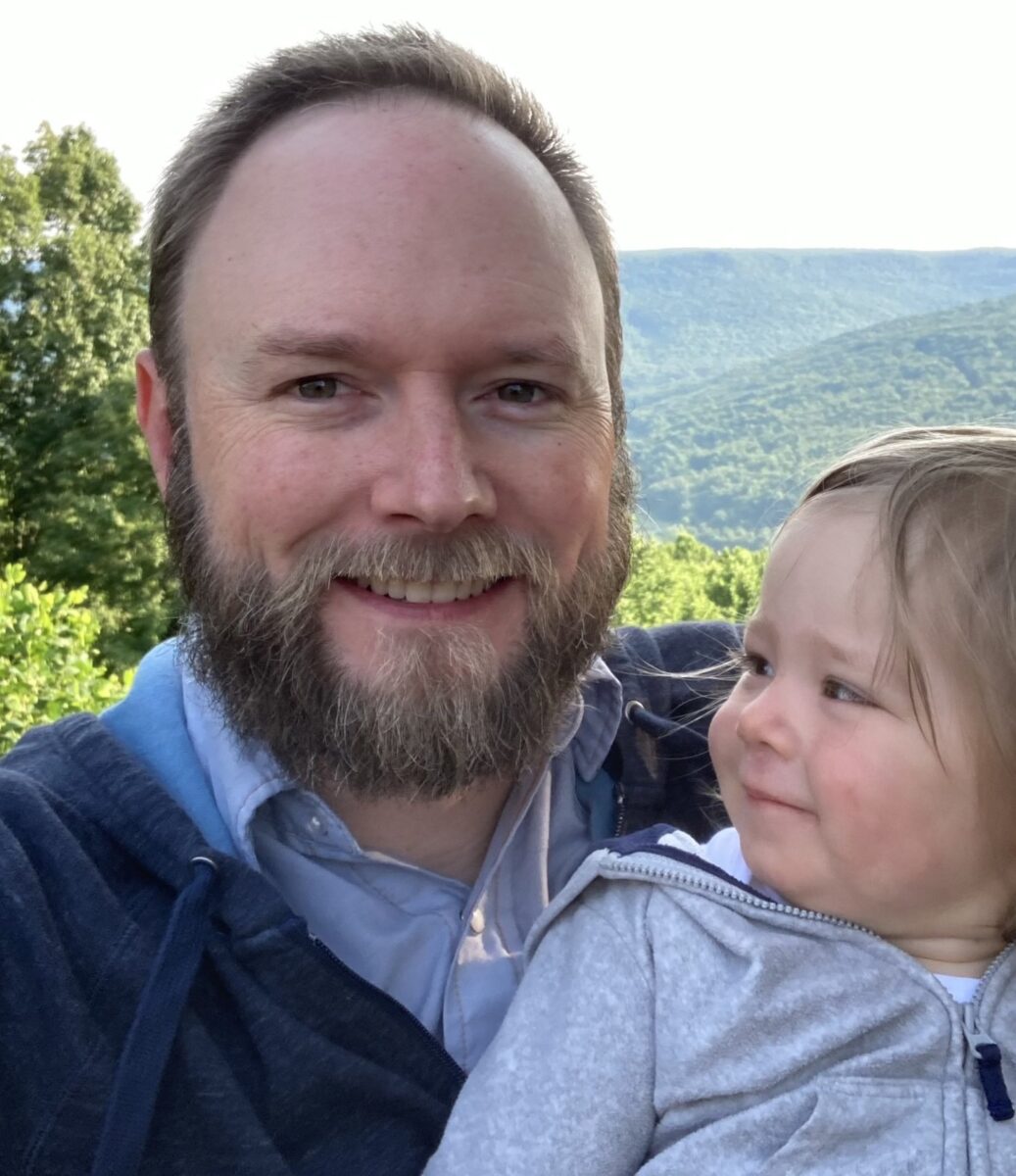

In the fall of 1958, parents of kids attending Creston Elementary School near Southeast Powell Blvd and Foster Road decided they were tired of the excuses. They wanted their kids to be able to cross Powell safely to get to school or to Creston Park, and they were going to put their bodies on the line to make it happen.
Almost 65 years later, after many serious crashes on Powell that have claimed the lives and limbs of people trying to walk or bike across the street, advocates are still trying to get the message across. And thanks to a remarkable piece of transportation history we’ve just learned about from reader Dave Binnig, we now know that those parents used similar tactics to a protest on Powell late last year.
Binnig, who’s representing BikeLoud PDX in a workgroup formed after the death of Sarah Pliner last year, compiled old articles from The Oregonian about the protests near Creston Elementary and handed them out to attendees at the group’s recent meeting at Cleveland High School.
These articles tell a story that will seem very familiar to anyone involved in today’s efforts to make Portland’s streets safer for vulnerable road users. Binnig is hopeful that this time around we might see real changes on Powell, but he said the fact that we’ve made so little progress since 1958 is troubling.



“On the one hand it’s inspiring to see parents a couple generations ago were so committed to making Powell safer for their kids. On the other hand, it’s frustrating that 65 years later Creston parents are still asking for the same thing.”
– David Binnig
“On the one hand it’s inspiring to see parents a couple generations ago were so committed to making Powell safer for their kids. On the other hand, it’s frustrating that 65 years later Creston parents are still asking for the same thing,” Binnig said in an email to BikePortland.
The Creston parents — mostly moms from the Parent-Teacher Association — asked officials from the state, city and school district to help improve a crossing at Powell and SE 47th Ave, where kids were getting injured while trying to cross the street.
“A couple of additional amber safety blinkers have been installed at the intersection, but the mothers’ group does not think this sufficient. The crossing has a stop and go signal system which can be activated by the patrol boys whenever children cross,” an article in The Oregonian (PDF) written at the time states. “The well-traveled street carries a great amount of traffic, and there have been injuries to children at the crossing, mothers contend. The mothers’ group in the past has indicated it would like an elevated crossing or some other safety precaution.”
Since these changes didn’t come, the parents decided to protest by forming a human chain to block car traffic on Powell. They stayed there during crossing times for multiple days in a row until the city agreed to a plan to make the crossing safer. Judging from the articles, it seems like the parents first ran into bureaucratic challenges: one article states that then-Portland Mayor Terry Schrunk said “the city had no funds for safety improvements for the crossing and suggested the parents assess themselves to provide the extra facilities wanted.”
Eventually, the city agreed to a plan that included installing a push-button signal at the crossing (not a raised crosswalk) and the mayor presented the Creston PTA with flowers for their hard work. Today, however, people are still demanding changes be made to Powell Blvd so it’s safe for vulnerable road users to walk and bike across the street, and they feel like they’re in the same boat as these parents 65 years ago. In many ways, the situation has become even more dire.
But the coalition of advocates is broader now, and the message more far-reaching, even though many of the tactics they’re using to accomplish their goals are similar.
In the aftermath of the collision that killed Sarah Pliner in October, activists protested by forming a human-protected bike lane at the intersection. The images from that demonstration look very reminiscent of the human chain formed by Creston parents about 20 blocks east in 1958.
“And the dynamics are familiar, with the department of transportation (then the Oregon State Highway Department) saying these are complicated engineering questions, and a city government without enough money to take action on its own,” Binnig said. “In some ways we’re worse off now: in 1958 Powell in the Creston school area was a 4-lane road with a 20 mph school speed zone; now it’s a 5-lane road with no school speed zone.”
Binnig lives near Creston Elementary School, and frequently visits the school park with his young child. This has made the issue of safety on Powell all the more salient to him, and he sees how important parents are in the fight for safer streets. Powell Blvd is home to several schools, including Cleveland, Kellogg Middle School, St. Ignatius School and Creston, and parents of kids who attend these schools have been some of the most outspoken advocates for change in the last few months.
“In the course of serving on the Powell workgroup I’ve been more systematically focused on safety and usability challenges on SE Powell, and I think the school PTAs are some of the most compelling voices on the need to make changes,” Binnig said.
Thanks in part to the reaction from parents after Pliner’s death, the Oregon Department of Transportation implemented a school zone on the stretch of Powell near Cleveland High in October. ODOT is also conducting a new speed zone and lane realignment study of Powell in the Creston area, which activists hope will have a similar result. And with some state policymakers on their side, advocates believe this could be the time for real change on Powell. If it happens 65 years late, it will still be better than nothing.



